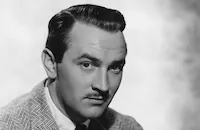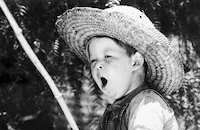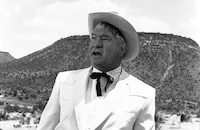Wyoming

Brief Synopsis
Cast & Crew
Richard Thorpe
Wallace Beery
Leo Carrillo
Ann Rutherford
Lee Bowman
Joseph Calleia
Film Details
Technical Specs

Synopsis
"Reb" Harkness and Pete Marillo are in the process of robbing a train in Missouri when the cavalry closes in on them. After escaping on Reb's horse, Pete double-crosses his partner and steals the animal, leaving Reb to face the soldiers on foot. Deciding to escape his pursuers by traveling to California, Reb meets Dave Kincaid, a discharged Confederate soldier, who invites him to ride along to his ranch in Wyoming. As they near the ranch, Reb steals Kincaid's horse and pack, but after Kincaid is murdered by cattle rustlers, Reb rides to the ranch to care for the slain man's daughter Lucy and son Jimmy. There Reb learns that the town's corrupt mayor, John Buckley, is forcing the ranchers from their lands, but Reb wants none of their fight. After killing one of Buckley's men for gunning down Kincaid, and delivering the dead man's money to Jimmy and Lucy, Reb plans to ride on to California, but his plans are postponed with the arrival of General George Custer, who has come to police the territory. When Buckley accuses Reb of murdering one of his men, Custer arrests him and places him in the custody of the town's weak-willed sheriff, who is also Buckley's tool. Plotting to rustle the remainder of the rancher's cattle, Buckley arranges for a diversion to compel Custer to go to Laramie. He then sets a trap for Reb, but Reb outwits him, escapes, and meets up with Pete again, who decides to help him. Upon learning that Buckley's men have killed Lafe, the brother of the town's female blacksmith, Mehitabel, Reb sides with the ranchers, but before a range war can escalate, Custer returns and declares martial law. Not to be deterred, Buckley arranges for an Indian massacre, but before he can benefit from his treachery, Reb shoots and kills him. After Reb and Custer's cavalry fend off the Indian attack, Reb decides to give up on California and settle down in Wyoming with Mehitabel, while Lucy and Sergeant Connelly, one of Custer's men, make plans of their own.

Director

Richard Thorpe
Cast

Wallace Beery

Leo Carrillo

Ann Rutherford

Lee Bowman

Joseph Calleia

Bobs Watson

Paul Kelly

Henry Travers

Marjorie Main

Addison Richards

Chill Wills
Edgar Deering
Russell Simpson

Clem Bevans

Donald Macbride

Glen Strange
Stanley Fields
William Tannen
Dick Curtis
Dick Alexander
Chief Thundercloud
Glenn H. Lucas
Archie Butler
Harley Chambers
George Guhl
Francis Mcdonald

Ethel Wales
Dick Botiller
Ted Adams
Harry Fleischmann

Howard Mitchell
Betty Jean Nichols
Art Belasco

Lee Phelps
Crew
Milton Bren
Hugo Butler
Jack Dawn
Clyde De Vinna
Randall Duell
Cedric Gibbons
Jack Jevne
Jack Jevne
Robert J. Kern
Douglas Shearer
David Snell
Gile Steele
Dolly Tree
Edwin B. Willis
Dolph Zimmer

Film Details
Technical Specs

Articles
Wyoming - WYOMING
Beery was, by 1940, a Hollywood veteran with hit movies like The Champ (1931) and Viva Villa! (1934) under his belt. But Marjorie Main was a relative newcomer. She'd visited Hollywood and made a few scattered film appearances (Her screen debut was in A House Divided, 1931). But it wasn't until 1937, and a reprisal of her stage role in the film adaptation of Dead End (1937), that Main had much big screen success. Main was born Mary Tomlinson in 1890 in Acton, Indiana. With the reluctant support of her preacher father, she attended dramatic school and eventually joined a local stock company where she changed her name to avoid embarrassing the family. As the story has it, she chose Marjorie Main because it was easy to remember. Main made her Broadway debut in 1916, where she worked, among others, with W.C. Fields. Her memorable portrayal of a dead gangster's mother in Dead End translated well to the big screen opposite Humphrey Bogart, and brought Main to Hollywood permanently.
Of course Beery's most successful pairing to date had been with the late Marie Dressler in such movies as Tugboat Annie and Dinner at Eight (both 1933). As the promotional tag line for Wyoming suggested - "1940's Min and Bill" (an early talkie starring Beery and Dressler) - the studio had been looking for another saucy female to butt heads with Beery. And the chemistry worked, beyond anyone's expectation. The pair proved such a crowd pleaser that MGM signed Main to a seven year contract and teamed Beery with her in five more films: Barnacle Bill (1941), The Bugle Sounds (1941), Jackass Mail (1942), Rationing (1944) and Bad Bascomb (1946).
But it's for a series of films without Beery that Marjorie Main is best remembered. It all started in 1947, when she appeared with Claudette Colbert and Fred MacMurray as neighbor Ma Kettle in The Egg and I. The role won Main her only Oscar nomination as Best Supporting Actress and kicked off another nine Ma and Pa Kettle movies, most of which co-starred Percy Kilbride. Each of the Kettle movies was filmed in less than 30 days and cost under $500,000. But in all, the series took in $35 million.
Main never really took to the glitz of Tinseltown. She lived in a rented apartment, did her own housework and reportedly took the bus to the studio. In later years, she did own a car (though still preferred to ride a bicycle) and several houses, where she had no servants except for a gardener who helped her in the yard. Main knew her strengths, and once remarked about her acting, "character actors are best, I believe, when they portray characters that give them a chance to draw on their own experiences, backgrounds and observations. Imagine me trying to play a society woman." She was as down to earth as her characters and her plain-speaking Wyoming blacksmith named Mehitabel was no exception.
Producer: Milton H. Bren
Director: Richard Thorpe
Screenplay: Hugo Butler, Jack Jevne
Art Direction: Cedric Gibbons Cinematography: Clyde De Vinna
Editing: Robert J. Kern
Music: David Snell
Cast: Wallace Beery (Reb Harkness), Leo Carrillo (Pete Marillo), Ann Rutherford (Lucy Kincaid), Lee Bowman (Sgt. Connelly), Joseph Calleia (John Buckley), Bobs Watson (Jimmy Kincaid), Marjorie Main (Mehitabel), Henry Travers (Sheriff), Addison Richards (Kincaid), Paul Kelly (General Custer).
BW-89m.
By Stephanie Thames

Wyoming - WYOMING
Quotes
Trivia
Notes
The working title of this film was Bad Man from Wyoming. According to a news item in Hollywood Reporter, it was filmed on location around Jackson Hole, WY, and the Teton Range.
















